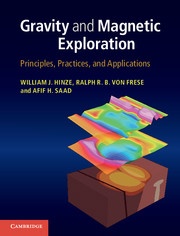Book contents
- Frontmatter
- Dedication
- Contents
- Preface
- Acknowledgements
- 1 Introduction
- Part I Gravity exploration
- Part II Magnetic exploration
- 8 The magnetic method
- 9 Magnetic potential theory
- 10 Magnetization of Earth materials
- 11 Magnetic data acquisition
- 12 Magnetic data processing
- 13 Magnetic anomaly interpretation
- Part III Applications
- Appendix A Data systems processing
- References
- Index
10 - Magnetization of Earth materials
from Part II - Magnetic exploration
Published online by Cambridge University Press: 05 May 2013
- Frontmatter
- Dedication
- Contents
- Preface
- Acknowledgements
- 1 Introduction
- Part I Gravity exploration
- Part II Magnetic exploration
- 8 The magnetic method
- 9 Magnetic potential theory
- 10 Magnetization of Earth materials
- 11 Magnetic data acquisition
- 12 Magnetic data processing
- 13 Magnetic anomaly interpretation
- Part III Applications
- Appendix A Data systems processing
- References
- Index
Summary
Overview
The magnetic method is based on variations in the magnetic field derived from lateral differences in the magnetization of the subsurface. As a result, an understanding of the magnetization of Earth materials, and the physical and geologic factors that control it, is essential in planning surveys as well as interpreting magnetic anomalies.
Magnetization consists of the vectorial addition of induced and remanent components. Induced magnetization depends on the magnetic susceptibility of the material and the magnitude and direction of the ambient magnetic field, while remanent magnetization reflects the past magnetic history of the material. This makes the prediction of the magnetization of Earth materials difficult in many geological situations. This problem is amplified because, unlike rock densities which vary by only a few orders of magnitude, magnetizations commonly have a range of 103 or more. The resulting uncertainty in estimating magnetization is made greater by the fact it is controlled by a few minerals that occur only as accessory constituents in essentially all Earth materials. As a result, material types do not have diagnostic magnetic properties, but useful generalizations can be made based on an understanding of the nature of the constituent magnetic minerals and the thermal and magnetic history of a specific geologic formation. Measurements of magnetic susceptibilities generally are made on samples using an induction balance, and remanent magnetism is determined by measuring the total effect on a magnetic sensor of rotating an oriented sample around three perpendicular axes.
- Type
- Chapter
- Information
- Gravity and Magnetic ExplorationPrinciples, Practices, and Applications, pp. 252 - 275Publisher: Cambridge University PressPrint publication year: 2013



